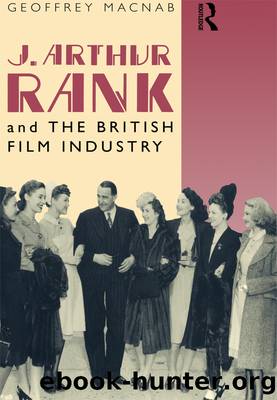J. Arthur Rank and the British Film Industry by Macnab

Author:Macnab [Macnab]
Language: eng
Format: epub
Tags: Social Science, Media Studies
ISBN: 9781135087203
Google: N56LAgAAQBAJ
Publisher: Routledge
Published: 2013-01-11T04:44:33+00:00
DAVID HAND AND GAUMONT-BRITISH ANIMATION
Rank's attempts to set up an animation department to rival Disney failed to spawn a Mickey Mouse, a Donald Duck, or even a Pluto; Corny the
Figure 3 Cartoon figures from G-B Animation: Corny the Crow, Ginger Nutt and Dusty the Mole
Crow, Ginger Nutt and Dusty the Mole, not to mention Ferdy the Fox, were the best that his cartoonists could come up with, and they were never embraced by the public in the way their American counterparts were.
In 1944, Rank had head-hunted David Hand, one of the top names in American animation. In a career stretching back to 1919, Hand had been employed with Popeye and Betty Boop's creators, the Fleischer brothers, on their 'Out of the Inkwell' series, and with Walt Disney. At Disney, his credentials were impressive: he was the supervising director of the first-ever cartoon feature, Snow White and the Seven Dwarfs, and had worked in the same capacity on Bambi and on the innovative wartime history of aviation, Victory through Air-Power: a Titan of the industry, he was generally reckoned to have the graphic and administrative skills to lay the foundations for a British cartoon revival. Rank gave him a 5-year contract and complete authority. Hand brought with him as assistants Roy Paterson, a Tom and Jerry veteran from MGM's Animation Department, and Ralph Wright, a 'storyman' from Disney, who had 'created' Pluto. The trio had big plans. First, they ensconced themselves in Soho. Then they set about recruiting artist-animators. They planned, eventually, to make cartoon films for world release, but would first cut their apprentices' teeth on educational, religious, industrial and commercial shorts.
At the end of the war, the Gaumont-British Animation Department, as Hand's outfit was called, was moved out of London to more spacious country surroundings: they took over Odeon Theatres' wartime retreat, Moor Hall, a country house in leafy Cookham, quickly installing their elaborate equipment, and housing their young apprentices in dormitories. Early, ambitious projects, none of which came to fruition, were to make feature-length cartoons of Lewis Carroll's The Hunting of the Snark; to adapt The Wind in the Willows in a dozen 10-minute episodes; and to tread on Korda territory with an epic, animated version of The First Men in the Moon, the novel by H.G. Wells.
A raw young apprentice at Cookham, later a successful television 'personality', was Bob Monkhouse, whose mother spotted a recruitment ad for G-B Animation in the local press. Monkhouse recalls being awestruck by Hand: 'He was one of the most impressive men I've met in my life ... a super-executive.'22 He remembers that in his time at Cookham, J. Arthur Rank came down to visit them only once. Rank was aloof and distant: 'He was a big, plain-spoken man who shook hands with us reluctantly.'23 Soon, Hand's staff had ballooned to 120: 80 artists, 20 technicians, and 20 clerical and other workers. (At its peak, G-B Animation was employing more than 200.) There were 3,000 people working in the American cartoon industry. Hand claimed he could envision the day when there would be 5,000 in the British.
Download
This site does not store any files on its server. We only index and link to content provided by other sites. Please contact the content providers to delete copyright contents if any and email us, we'll remove relevant links or contents immediately.
The Kite Runner by Khaled Hosseini(5133)
Gerald's Game by Stephen King(4610)
Dialogue by Robert McKee(4353)
The Perils of Being Moderately Famous by Soha Ali Khan(4194)
The 101 Dalmatians by Dodie Smith(3482)
Story: Substance, Structure, Style and the Principles of Screenwriting by Robert McKee(3420)
The Pixar Touch by David A. Price(3390)
Confessions of a Video Vixen by Karrine Steffans(3275)
How Music Works by David Byrne(3234)
Harry Potter 4 - Harry Potter and The Goblet of Fire by J.K.Rowling(3032)
Fantastic Beasts: The Crimes of Grindelwald by J. K. Rowling(3030)
Slugfest by Reed Tucker(2974)
The Mental Game of Writing: How to Overcome Obstacles, Stay Creative and Productive, and Free Your Mind for Success by James Scott Bell(2876)
4 - Harry Potter and the Goblet of Fire by J.K. Rowling(2685)
Screenplay: The Foundations of Screenwriting by Syd Field(2602)
The Complete H. P. Lovecraft Reader by H.P. Lovecraft(2531)
Scandals of Classic Hollywood: Sex, Deviance, and Drama from the Golden Age of American Cinema by Anne Helen Petersen(2491)
Wildflower by Drew Barrymore(2467)
Robin by Dave Itzkoff(2413)
